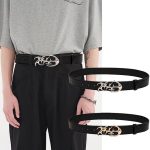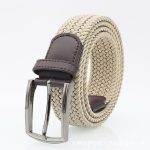Leather belts, a staple in both men’s and women’s wardrobes, can vary widely in terms of their texture and feel. The question “Is a leather belt soft or hard?” doesn’t have a straightforward answer. The texture of a leather belt is influenced by several factors, including the type of leather, the tanning process, and the finishing techniques used. Let’s unravel the complexities behind leather belt textures and understand what contributes to their softness or hardness.
Understanding Leather Types
Different types of leather exhibit distinct characteristics, influencing their softness or hardness.
- Full-Grain Leather: This is the highest quality leather, retaining the natural grain and surface of the animal hide. It’s known for its durability and develops a beautiful patina over time. However, it can be initially stiff and requires some breaking in to become supple.
- Top-Grain Leather: The surface of top-grain leather is sanded and treated to remove imperfections, resulting in a more uniform appearance. While still durable, it’s generally softer than full-grain leather.
- Genuine Leather: This term encompasses various lower-quality leathers that have been processed and treated. Genuine leather belts can vary significantly in texture, ranging from relatively soft to quite stiff, depending on the specific processing methods used.
- Bonded Leather: This is a composite material made from leather scraps and fibers bonded together with adhesives. It’s generally less durable and can feel stiff and artificial compared to genuine leather.
The Role of Tanning
The tanning process, which transforms animal hides into leather, also plays a role in determining its texture.
- Vegetable Tanning: This traditional method uses natural tannins derived from plants, resulting in a firm and durable leather that develops a rich patina over time. However, vegetable-tanned leather can be initially stiff and requires conditioning to become supple.
- Chrome Tanning: This modern method uses chromium salts to tan leather, producing a softer and more pliable material. Chrome-tanned leather is often used for belts intended for casual wear due to its comfort and flexibility.
Finishing Touches: The Impact of Finishing Techniques
The finishing techniques applied to leather can further influence its texture and feel.
- Oiling and Waxing: Applying oils and waxes to leather can enhance its suppleness and create a smooth, luxurious feel.
- Buffing and Embossing: These techniques can alter the surface texture of leather, making it smoother or adding decorative patterns.
- Pigmenting and Dyeing: Coloring leather can affect its texture, with some pigments adding a slight stiffness to the material.
Many leather belts, especially those made from full-grain leather, can be quite stiff initially. However, with regular wear and proper care, they will gradually soften and mold to your body shape, becoming increasingly comfortable over time. This process is often referred to as “breaking in” the leather.

Choosing the Right Leather Belt
When selecting a belt, consider its intended use and your personal preferences.
Formal vs. Casual
For formal occasions, a sleek and polished belt made from top-grain or full-grain leather is a classic choice. For casual wear, a more relaxed and supple belt made from chrome-tanned leather might be preferable.
Comfort and Fit
Ensure the belt fits comfortably around your waist without feeling too tight or restrictive. Consider the width and thickness of the belt, as well as the buckle style, to ensure a comfortable fit.
Durability and Longevity
If you’re looking for a belt that will last for years, invest in a high-quality leather belt made from full-grain or top-grain leather.
Leather belts can range in texture from soft and supple to firm and sturdy. The type of leather, tanning process, and finishing techniques all contribute to the final feel of the belt. By understanding these factors and considering your individual needs and preferences, you can choose a leather belt that not only complements your style but also provides the comfort and durability you desire.
The Allure of a Worn-In Leather Belt
While a brand new leather belt might be a bit stiff and unyielding, the true beauty of leather lies in its ability to transform over time. With regular wear and proper care, a leather belt develops a unique character and patina, becoming a reflection of your personal journey.
The Softening Process
As you wear a leather belt, the natural oils from your skin, combined with the flexing and bending of the material, gradually soften and supple the leather.
Unique Patina
Over time, a leather belt develops a distinctive patina, a rich and nuanced coloration caused by exposure to the elements, oils, and everyday wear and tear. This patina adds character and individuality to the belt, making it truly one-of-a-kind.
Comfortable Fit
A worn-in leather belt molds to the contours of your body, creating a custom fit that feels comfortable and supportive.
The Tactile Pleasure of Leather
Beyond its visual appeal, leather offers a unique tactile experience.
Sensory Delight
Running your fingers along a well-conditioned leather belt can be a sensory delight, appreciating the smoothness, suppleness, and natural warmth of the material.
Connection to Nature
Leather, being a natural material, evokes a connection to nature and the animal it originated from. This can be particularly appealing to those who value authenticity and craftsmanship.
The Versatility of Leather Belts
Leather belts are incredibly versatile accessories that can elevate any outfit, from casual to formal.
Casual Chic
Pair a brown leather belt with jeans and a t-shirt for a relaxed yet stylish look.
Business Attire
A black leather belt with a subtle buckle complements a suit or dress pants perfectly, adding a touch of sophistication.
Statement Piece
A bold, wide leather belt with an eye-catching buckle can become a statement piece, adding personality and flair to a simple outfit.

Leather Belts: An Investment in Style and Durability
Investing in a high-quality belt is a wise decision. It not only enhances your style but also provides long-lasting durability.
Timeless Appeal
Leather belts transcend fleeting fashion trends, remaining a classic and stylish accessory for years to come.
Cost-Effective
While the initial cost might be higher than synthetic alternatives, a leather belt’s longevity and durability make it a cost-effective investment in the long run.
Sustainability
Opting for ethically sourced and sustainably tanned leather supports responsible practices and minimizes environmental impact.
A Word of Caution
While DIY softening techniques can be effective, it’s important to exercise caution to avoid damaging your leather belt.
Test in an Inconspicuous Area
Before applying any softening agent to the entire belt, test it on a small, hidden area first to ensure it doesn’t cause discoloration or other adverse effects.
Start with Small Amounts
Apply oils or conditioners sparingly, adding more as needed. Over-conditioning can make the leather too soft or greasy.
Avoid Harsh Chemicals
Steer clear of harsh chemicals or abrasive cleaners, which can damage the leather’s surface and compromise its durability.
Patience is Key
Softening leather takes time and patience. Don’t expect instant results, and repeat the process as needed until you achieve the desired level of suppleness.

Embrace the Beauty and Versatility of Leather Belts
Whether you prefer a soft and supple belt or a more robust and sturdy one, leather belts offer a timeless and versatile accessory that complements any wardrobe. From their functional origins to their modern-day fashion status, leather belts have evolved alongside human civilization, reflecting our appreciation for natural materials, craftsmanship, and personal style. So, next time you buckle up your leather belt, take a moment to appreciate its rich history, unique texture, and the journey it will take with you.


